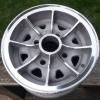Using C-Aeg105 Ex Valve As Inlet Valve
#1

Posted 25 December 2018 - 07:40 PM
#2

Posted 26 December 2018 - 03:10 AM
I would be interested on the thoughts of the people who have looked at this. As I am only going from a poor memory.
#3

Posted 26 December 2018 - 07:15 AM
While I don't have the lengths to hand, that would need to be checked, however, the stem diameters between Inlet and Exhausts are different, which Exhausts being around 0.0015" smaller, so using one as an Inlet will almost certainly result in higher oil consumption.
The other issue is as Nick has mentioned, with regards to the shape behind the valve head.
It is less than ideal.
#4

Posted 26 December 2018 - 09:36 AM
Phil.
#5

Posted 26 December 2018 - 06:41 PM
Interesting...….
Edited by neal, 26 December 2018 - 06:55 PM.
#6

Posted 26 December 2018 - 09:15 PM
#7

Posted 26 December 2018 - 10:49 PM
In the Yellow Bible, you can see arrows representing air flow across the back of the valve especially at lower lifts which shows that a thin valve head is advantageous vs. a tulip shape.
#8

Posted 27 December 2018 - 12:49 AM
In the Yellow Bible, you can see arrows representing air flow across the back of the valve especially at lower lifts which shows that a thin valve head is advantageous vs. a tulip shape.
For a 5 port A -series intake port that is certainly true.
Phil.
#9

Posted 27 December 2018 - 12:56 AM
In the Yellow Bible, you can see arrows representing air flow across the back of the valve especially at lower lifts which shows that a thin valve head is advantageous vs. a tulip shape.
For a 5 port A -series intake port that is certainly true.
Phil.
Well the thicker the valve head and stem the less the volume of air can be passed at lower lifts for all applications. At higher lift (not high lift) the restriction is less.
#10

Posted 27 December 2018 - 09:29 AM
On other heads the steeper the port becomes the more the tulip shape valve can become an advantage as the air can use more of the valve area and doesn’t just tend to flow across it but rather down and around it, a sort of funnelling effect. A thicker stem obviously won’t help in any situation.
Phil.
Edited by Turbo Phil, 27 December 2018 - 09:31 AM.
1 user(s) are reading this topic
0 members, 1 guests, 0 anonymous users


















